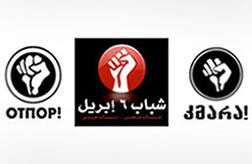Images from left to right: Otpor; April 6 Movement; Kmara
Abstract: The uprisings witnessed throughout the Middle East have lent
new credence to the power of youth movements and nonviolent resistance in authoritarian
settings. Mounting evidence indicates that youth activities from Egypt to Algeria
have benefited from the lessons of their contemporaries in post-Communist Europe.
Yet the lessons of Serbia, Georgia, Ukraine and elsewhere have bearing beyond
the immediate revolution. This article examines the untold story of Otpor, the
Serbian youth movement now heralded for having influenced Egypt's youths. It looks
beyond the parallels of revolutionary methods, to the sources of Otpor's ultimate
collapse in Milosevic's absence. In doing so, it draws out lessons that may be
applied to current and future youth movements throughout the Middle East as they
lay the groundwork for post-revolutionary democracy.
The political demise of Hosni
Mubarak has captured the world's attention, galvanizing democracy's enthusiasts
in what was to have been another "dark
year" for democracy. Unpredictable and in many respects unprecedented,
the uprisings witnessed throughout the Middle East have breathed new
life into the democracy promotion industry. And yet, for all their novelty,
the events in Egypt offer a narrative with which we are all familiar.
The story goes something like this: For years, an authoritarian regime uses
violence and repression to maintain its rule. Regime cronies are awarded lucrative
access to state coffers, while a nascent political opposition is divided and
harassed, imprisoned and sometimes, murdered. For years, foreign leaders condone
the regime's longevity in the name of regional stability, its unsavory character
legitimized by reference to historical grievances and cultural deficits. Then,
suddenly, the regime collapses. Nation-wide protests, inspirational acts of
nonviolent resistance, and an undaunted youth movement force the regime to its
knees. As analysts attempt to make sense of the changes, they credit cell phones,
savvy marketing strategies, and most recently, social media tools. They attribute
the demand for democracy to foreign policy makers, foreign aid, and models derived
from neighboring states and the far abroad. For days and sometimes, weeks, the
world is enraptured. And then, just as quickly, public interest fades.
Of course, the story of revolutionary upheaval does not end with the unseating
of a dictator. All too often, authoritarian regimes fall only to rise again,
altered in name but not in substance. Just as frequently, those at the forefront
of change—those leading the protests, dodging the bullets, and building
the barricades—struggle to find purpose in its aftermath. For members of
the anti-regime opposition, their newfound unity and empowerment frequently
proves ephemeral, the demands of transition too great.
This experience can be particularly disillusioning for a nation's youth, many
of whom bear the greatest risks and make the steepest sacrifices in the midst
of revolution. As post-revolutionary reverie fades, youths are often among the
first to be disenchanted by the pitfalls of transition and the seeming endurance
of the status quo. Young people—so vital for the ousting of a dictator—become
passive observers in the subsequent transition, their passion and ingenuity
left untapped by newly democratic authorities.
As we learn of the role young Egyptians have played in Mubarak's unseating,
it is difficult not to draw parallels to the similarly courageous feats of youths
and youth movements throughout the post-Communist space. For all the differences
distinguishing the Egyptian from the post-Communist experience—and there
are many—there are also significant similarities which deserve further
investigation. In particular, there is mounting evidence that Egyptian groups
such as Kefaya
(Arabic: Enough!), the April
6 Youth Movement, and Youth for Change built upon and adapted revolutionary
models employed by young activists in Serbia, Georgia, Ukraine, and elsewhere.
Adhering to the tenants of nonviolent resistance, their strategies and tactics
evoked those so successfully employed by youth movements such as Otpor
(Serbian: Resistance!), Kmara
(Georgian: Enough!), and Pora
(Ukrainian: It's Time!) in the run-up to the "color revolutions" of
the early 2000s. The role of Otpor is likely to have been particularly profound.
Formed in late 1998 by a handful of student activists uneasy with the Serbian
regime's increasingly authoritarian tone, Otpor became the dominant symbol of
anti-Milosevic
opposition. Through a horizontal network of Otpor "hubs" in villages,
towns, and cities across Serbia, Otpor activists honed the lessons of nonviolent
resistance developed by American scholar Gene
Sharp and retired U.S. Army Colonel Robert Helvey. Waving the clenched
fist of resistance, young people across Serbia risked their safety—and
sometimes their lives—to partake in covert actions against the regime.
Thanks to the ingenuity of its activists and its seemingly leaderless construction,
Otpor developed into a genuinely national network, boasting its own press office
and in-house training center, capable of setting loose thousands of eager anti-regime
activists throughout Serbia. For months, Otpor lambasted the Milosevic regime,
pressing the chronically fissiparous Serbia opposition to unite. It organized
massive theatrical events and concerts across Serbia, all with the aim of delegitimizing
the regime and undermining its rule of intimidation.
When in October 2000 Milosevic resigned amidst a wave of mass uprisings reminiscent
of those now witnessed throughout the Middle East, many attributed his fall
to Otpor. As a consequence, in the years that followed Otpor came to symbolize
the power of the people—above all, young people—in confronting oppression.
Yet according to Rade Milic, a long-time Otpor activist, "Otpor
became more than a symbol-it became a methodology. We were the experts in leading
nonviolent resistance." Indeed, members of Otpor soon set about sharing
their experiences and techniques with clandestine activists in Georgia, Ukraine,
Belarus, Lebanon, and elsewhere. Srdja
Popovic, an Otpor founder and current director of the Center for Applied
Nonviolent Action and Strategies (CANVAS), claims
to have met with and trained activists from 37 different countries, including
several from the Middle East. According to several accounts,
as well as the admission of Popovic himself, Otpor activists not only inspired,
but shared insights with aspiring Egyptian revolutionaries in the years preceding
the February 2011 changes.
It is tempting to view the lessons of Otpor as assuming relevance solely for
the build-up to regime change. The lessons of "people power" and non-violent
resistance offer a compelling narrative that fits comfortably within our conceptions
of democracy's primacy. Yet the story of Otpor continued long after Milosevic's
fall. Its import for budding revolutionaries did not end with the changes of
October 2000. To the contrary, in the years that followed Serbia's "Bulldozer
Revolution," Serbia underwent a protracted transition that included
the assassination of a reformist prime minister, the resurgence of the far-right
Serbian Radical Party—whose leader sits before The Hague Tribunal accused
of instigating war crimes and atrocities—and a legacy of corruption and
nepotism that continues to pervade its politics.
The situation for Serbia's youth has been particularly dire. The vast majority
of Serbia's youths are unemployed. Most have never traveled beyond Serbia's
borders, and a growing number cite their sympathies with Serbia's most reactionary
forces. Despite young people's clear need for an instrument through which to
voice their concerns, however, Otpor disbanded soon after Milosevic's departure.
A similar fate was ultimately met by Pora and Kmara.
In fact, the post-communist space is littered with the remnants of youth movements
of revolutions past. Their absence after revolution is as striking as their
presence within it. So instrumental in driving revolutionary changes, young
people are among the first to be disenchanted by post-revolutionary realities—left
without jobs, without a clear vision for change, and without a vehicle through
which to channel their grievances. Should Egypt's youth wish to escape a similar
fate, several lessons are worth noting.
Craft an Identity beyond the Dictator
By the eve of Slobodan Milosevic's ouster in October 2000, Otpor had gained
national prominence. The organization's hitherto low profile leaders became
a magnet for domestic and international journalists, eager to learn the secrets
behind their success. For months, Otpor activists were featured guests on national
television and radio outlets, they gave lectures and speeches at universities
around the world, were the recipients of MTV's "Free your Mind" award,
and even helped design video
games simulating the strategies of nonviolent resistance. Long under the
influence of Milosevic's anti-Otpor propaganda, Serbia's citizens, old and young
alike, embraced these courageous young leaders with a level of trust and hope
they never espoused for Serbia's political class.
As a consequence, Otpor boasted tremendous leverage in the months following
Milosevic's resignation. Unfortunately, it did not know what to do with it.
An intensely heterogeneous movement comprised of leftists and conservatives,
monarchists and republicans, nationalists and cosmopolitans, with Milosevic's
departure Otpor lost the glue that bound it together. Without their shared disdain
for Milosevic to unite them, Otpor members could not agree on how to proceed.
They bickered not only over the concrete steps Serbia's first post-Milosevic
government should take, but also over the movement's identity and its future.
Some believed that post-Milosevic, Otpor had no further role to play—its
goal accomplished, its rationale now outdated. Others hoped for the formation
of a watch dog agency, whereby Otpor would monitor Serbia's newly elected authorities
and keep the promise of democracy alive. Still others believed Otpor should
transform itself into a political party, mounting the call for change from within
the structures of power.
For months, Otpor struggled to reach a consensus on these matters. When three
years later Otpor emerged as a political party, it was too little, too late.
Otpor had failed to resonate with the voters and it received less than 2 percent
of the national vote.
Resist the Temptation to Politicize
Though the retelling of Otpor's story has tended to downplay the political backgrounds
of Otpor's founding members, the reality was always more complicated. From the
very beginning, Otpor members combined their status as students with a penchant
for political activism. Many were members of oppositional parties, with political
ambitions of their own. In the wake of revolution, numerous Otpor functionaries—including
some of the organization's foremost leaders—departed the movement in the
hopes of rejoining their respective parties and launching independent careers
within the new government. Today, former Otpor members boast a significant presence
within the highest echelons of power. Serbia's controversial foreign minister,
Vuk Jeremic, is just one example of a former Otpor activist who successfully
made the transition into politics.
The influx of Otpor members may have strengthened Serbia's political coterie,
but it had decidedly negative consequences for the movement itself and for Serbian
civil society more generally. Otpor lost many of the visionaries that once defined
its spirit in the run-up to Milosevic's ouster. Perhaps more significantly,
Serbian civil society was deprived of young, vibrant activists, leaving it too
weak to convincingly counterbalance the powers of political society.
Yet the final straw came with Otpor's decision to forge a political party. When
in 2003 Otpor opted to stand for elections, it lost the credibility that had
defined it within Milosevic's Serbia. Paradoxically, what was once a student
movement, comprised of young activists—many younger than 14—became
a political party dominated by adults.
More importantly, the transformation into a political party meant that Otpor
had to drastically change its structure and methods of operation. Like all political
parties, it had to establish clear leadership and a pyramidal structure that
ran contrary to the decentralized nature of its revolutionary politics.
In doing so, Otpor sacrificed a major tenet of its struggle against Milosevic:
the (seeming) absence of a leader. One of Otpor's strengths in Milosevic's Serbia
had been its refutation of formal, bureaucratic procedures. This fluidity allowed
Otpor to embrace Serbs of all backgrounds and opinions, and is what made it
so attractive for Serbia's youth, so disenchanted by traditional political parties
and their corrupt practices. Ironically, however, it is also what delegitimized
Otpor the party.
When in 2003 Otpor failed to enter parliament, the organization quickly disbanded.
Those at the top of the party traded their revolutionary garb for comfortable
positions within the larger, pro-establishment Democratic Party. Otpor's fate
was thus relegated to the dustbin of Milosevic-era politics.
The impact of Otpor's unraveling for Serbia's youth has been profound. Serbia's
young people lack a stake in the system. They have no effective means to voice
their concerns, and no clear instrument through which to channel their discontent.
Otpor could perhaps have provided such a vehicle had its leaders made the transition
not to politics, but to youth advocacy. Just as they once resisted a dictator,
so too might they have resisted the subsequent political disenfranchisement
that has afflicted youths across Serbia and the greater Balkans region.
Maintain an Independent Agenda
In the weeks and months following Milosevic's ouster, the events of October 5th came under increasing scrutiny as scholars and policymakers sought to identify the factors enabling the Serbian opposition's success. Before long, a common narrative had emerged in which a single factor loomed large: foreign intervention. In the U.S., the Washington Post reported that "U.S.-funded consultants played a crucial role behind the scenes in virtually every facet of the anti-Milosevic drive." In Germany, Der Spiegel applauded "massive political and material support from Berlin" for having "contributed to the fact that opposition groups and parties could develop the strength to force Milosevic to surrender." Even Thomas Carothers—not one to exaggerate foreign intervention's impact—acknowledged the exceptional role Western actors played in facilitating Milosevic's ouster.
Of all the forms of foreign intervention—and there were many—it was
overt democracy assistance that won the greatest praise. Proponents of such
assistance were eager to brand "their" Serbian experiment as an emblem
of aid's utility. Thus, the distributors of U.S. aid to Eastern Europe credited
their assistance for having played a "key role" in regime change by
providing Serbia's citizens "the tools [they] needed to liberate themselves".
Similarly, the Office of Transition Initiative (OTI) identified its assistance
as one of but three factors accounting for the "surprising and extraordinary
defeat of Milosevic."
Not surprisingly, much of the credit was bestowed upon those organizations that
had offered funds and support to Otpor—among them OTI, the Open Society Institute,
the National Endowment for Democracy, Freedom House, and the International Republic
Institute. In the aftermath of the NATO bombing of Serbia, these organizations
offered material and financial assistance to Otpor activists-sponsoring trainings
and workshops in neighboring Budapest, connecting Otpor functionaries with the
likes of Sharp and Helvey, and funding the arsenal of Otpor-embellished stickers,
matchboxes, and posters that dotted the Serbian landscape.
Unfortunately, the emphasis on the external factors driving Serbia's revolutionaries did little to bolster the domestic prestige of Otpor, whose activists had long struggled to dispel any notion of their dependence on Western governments. Though clearly a boon for the democracy promotion industry, the all too public praise bestowed upon the international community came largely at Otpor's expense.
Many donors rushed to join the Otpor bandwagon after October 5th, in an effort to lay claim to Otpor's victories. The organization was thus inundated with external assistance, but lacked a vision for how to channel it. The funds soon exceeded Otpor's means, and the organization quickly gained a reputation (however undeservedly) for corruption and self-enrichment. Otpor's failure to clearly disassociate itself from foreign aid in the aftermath of regime change ultimately spelled its doom, and made its entry into mainstream politics all the more arduous.
Lessons for Egypt and Elsewhere
In the coming weeks and months, we are likely to learn of more uprisings, more
bastions of discontent, and quite possibly, more revolutions. As we do, analysts
will be eager to locate the seeds of such resistance in virtual technologies,
cell phones, Facebook, Twitter, the lofty rhetoric of American policymakers,
and yes, even revolutionaries in post-Communist Serbia. Their efforts will often
seem to discount the hearts and minds of the region's youths. Invariably, however,
the struggles of Tunisians, Egyptians, Algerians, Iranians and others will be
their own, decided on their own terms.
Still, Otpor's experience is telling in several respects. Most importantly,
it elucidates the need to plan ahead, to think beyond the immediate goal of
regime change. Movements that are defined solely on the basis of a dictator's
ousting have little merit once that dictator is gone. Moreover, movements that
fail to identify themselves in positive terms—as for something beyond
the abstraction of "democracy," rather than simply against a sitting
regime—are unlikely to withstand the tests of time.
Also significant is the need to align oneself with the movement, rather than
a specific party, in the aftermath of regime change. Resisting the temptation
to move up the ranks of organized politics is difficult, but may well be in
the interest of democracy in the long-term. To maintain a presence within civil
society, serving as a voice for the disenfranchised, may provide an outlet for
those likely to suffer from post-revolutionary disillusionment.
Finally, Otpor's experience speaks to the need to maintain a safe distance from
external influences, even those that purport to support democracy. As Srdja
Popovic puts it, "cultivate
external support, get the knowledge and the material resources from those
offering it and use it for your movement's mission. But beware of their political
advice because successful revolutions are only those which are home grown."
Indeed, revolutions are made by revolutionaries, they are the products of their own people. The line that distinguishes outside influences that help from those that hurt is all too often a fine one.




